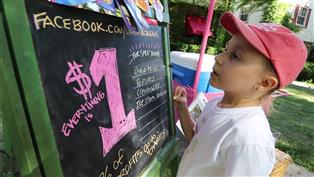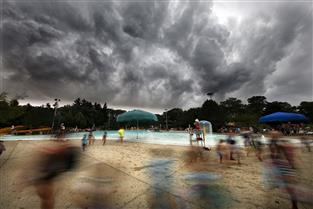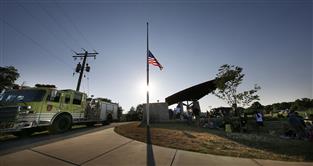Wauwatosa parents protest proposed bus rapid transit system

Above, in photos: Families walk in protest of bus rapid transit system plan
Families from the Ravenswood Circle subdivision gather up on March 23 to walk their children along Bluemound Road to St. Jude the Apostle School to protest a proposal for Bus Rapid Transit on Bluemound when traffic is so congested now that is difficult for children to walk to school. Staff photo by C.T. Kruger.
Dressed in hats and gloves and pressing against the wind, a group of Wauwatosa parents stood with their children outside their homes early morning March 23.
Many of the children present in the Ravenswood neighborhood that morning walk to school daily. And so do their parents.
The congested, busy roads, only elevated by the ongoing freeway construction are dangerous, many parents said, and they don't feel comfortable letting their kids walk to school on their own.
"The reason behind organizing this today is because they want to put this rapid transit system slicing down the middle of our neighborhood," said Adrienne Conradson, a mother of three students at St. Jude the Apostle School, 800 Glenview Ave. "It's already too dangerous, the cars already don't slow down."
Conradson was one of several parents gathered that morning to protest the proposed alternative mode of transportation.
Milwaukee County Executive Chris Abele announced last year the county would explore the development of a bus rapid transit system in the corridor between the region's two largest job centers, downtown Milwaukee and the Milwaukee Regional Medical Center in Wauwatosa.
Possible routes of the proposed system could be Wisconsin Avenue or Bluemound Road, both of which are near the Ravenswood neighborhood. However, the proposed project is currently in it's feasibility study phase, meaning no decision or exact routing has been made, according to Brendan Conway, chief marketing and communications officer for Milwaukee County Transit System.
Wisconsin Avenue, Bluemound Road and State Street are all being examined for possible routes, he said and money was put into the county's 2016 budget to study the possibility of such a project.
Bus rapid transit systems increases traffic speed as they allow buses to drive in separate, dedicated lanes, make fewer stops than typical buses and make it possible for the buses to be competitive with vehicle drive times.
The vehicles are often specialized and longer than a standard bus to increase passenger capacity, and they have several doors to permit faster boarding. Further, the vehicles use transit signal priority so they can keep stoplights green longer, if needed.
But the proposed project could make walking to school even more dangerous, said Jon Groth, also a parent of three.
"There are cars that go by and you have to yell and scream and say 'We're right here and we're trying to walk to school,'" he said.
Conradson said she has lived on Wisconsin Avenue for six years and moved to the area so that her kids could walk to school.
"I have an almost 10-year-old," she said. "He should be able to walk to school by himself. I can see the school from my living room. I can't, I'll never be able to let him walk to school alone."
Benefits of BRT
Conway said bus rapid transit systems have been "very, very successful" throughout the country and are beneficial as they offer commuters an alternate mode of transportation to work and cut back on downtown parking costs. Plus, businesses situated along the routes of the system could experience economic growth, he said.
There's already a bus route — the gold line — that runs down Wisconsin Avenue, said Conway. It's likely that if a bus rapid transit system were installed on that road, the gold line would be significantly scaled back or eliminated altogether, he said. Further, if a bus rapid transit system were installed, it's likely the number of automobiles on the roads would decrease as more and more people take advantage of the system.
"Bus rapid transit would generally either replace or mostly replace a local service," he said.
And residents shouldn't be worried about the line encroaching on their properties, he said.
"There's no scenario where BRT is looking at knocking down trees or taking down people's lawns," he said. "It would be done on existing roadways."
Conway said there's no exact cost estimate yet for the proposed system; many factors, including bus designs, among other things, play into the total cost. If the project is approved, residents could see the use of bus rapid transit systems as soon as late 2017 or early 2018, Conway said.
A number of public meetings about a possible bus rapid transit route, the benefits, funding and more are scheduled throughout the Milwaukee area over the coming months. A meeting is scheduled for 5 to 7 p.m. April 14 at the Milwaukee County Zoo's Zoofari Center.
Learn more
To learn more about the bus rapid transit system, follow updates on eastwestbrt.com. The website is expected to contain more information in the coming days.

E-mail Newsletter
Your link to the biggest stories in the suburbs delivered Thursday mornings.
Enter your e-mail address above and click "Sign Up Now!" to begin receiving your e-mail newsletter
Get the Newsletter!
More from News and Features
- Anodyne Coffee plans to open location in Wauwatosa Village
- Wauwatosa Meetings: Aug. 4
- Video: Wauwatosa girl's curbside ice cream stand raises money for the hungry
- Wauwatosa News and Notes: Hands-only CPR training offered; Firefly Art Fair is Aug. 6-7
- Wauwatosa Ask Now: Why are there barriers and fencing along the North Avenue bridges over the Menomonee River?
- Mystery Photo Contest: July 28
- Wauwatosa gears up for National Night Out event, this year at the zoo
- Election 2016: Wisconsin's 4th District candidates weigh in
- Wauwatosa's Luther Manor residents share smiles through flower delivery
- Wauwatosa Police Report: July 17-23















We welcome reader discussion but strive to keep things civil. Please see our discussion guidelines and terms of use for more information. If you see a comment that violates our guidelines, please flag it for review. If you have any other issues with our commenting system, please let us know.